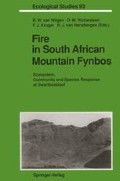Abstract
At first glance, patches of forest form distinct communities within the largely treeless fynbos shrublands. Forests usually occur on granite, shale and sandstone in sheltered ravines, stream banks and patches of rock scree (Fig. 5.1) where the annual precipitation is greater than 650 mm (Werger et al. 1972; McKenzie et al. 1977; Kruger 1979; Campbell 1985). The distribution of forests in the southwestern Cape conforms to the worldwide pattern of vegetation communities along watercourses differing in species composition from adjacent plant communities (Miller and Johnson 1986). The location of forests in moist habitats is often understood to reflect the climatic amelioration in these zones and the preclusion of forest species in the adjacent vegetation by seasonal drought (e.g. White 1978). Although the fynbos is fire-prone, forests seldom burn (van Wilgen et al. 1990b), and an alternative explanation for forest distribution is that the forests are remnants of previously more extensive forests which have been reduced by frequent fires (McKenzie et al. 1977; Campbell et al. 1979; Moll et al. 1980). The treeless nature of the fynbos is puzzling (see Chap. 9). Development of forest species has been noted in fynbos areas, usually in the prolonged absence of fire (Kruger 1984). Succession to forest has been noted after 50 fire-free years in Orange Kloof near Cape Town (mean annual rainfall 1227 mm) (Masson and Moll 1987) and was evident in places in the Swartboskloof valley (mean annual rainfall for the catchment: 2328 mm; see Chap. 2) after 28 fire-free years.
Access this chapter
Tax calculation will be finalised at checkout
Purchases are for personal use only
Preview
Unable to display preview. Download preview PDF.
Editor information
Editors and Affiliations
Rights and permissions
Copyright information
© 1992 Springer-Verlag Berlin Heidelberg
About this chapter
Cite this chapter
Manders, P.T., Richardson, D.M., Masson, P.H. (1992). Is Fynbos a Stage in Succession to Forest? Analysis of the Perceived Ecological Distinction Between Two Communities. In: van Wilgen, B.W., Richardson, D.M., Kruger, F.J., van Hensbergen, H.J. (eds) Fire in South African Mountain Fynbos. Ecological Studies, vol 93. Springer, Berlin, Heidelberg. https://doi.org/10.1007/978-3-642-76174-4_5
Download citation
DOI: https://doi.org/10.1007/978-3-642-76174-4_5
Publisher Name: Springer, Berlin, Heidelberg
Print ISBN: 978-3-642-76176-8
Online ISBN: 978-3-642-76174-4
eBook Packages: Springer Book Archive

